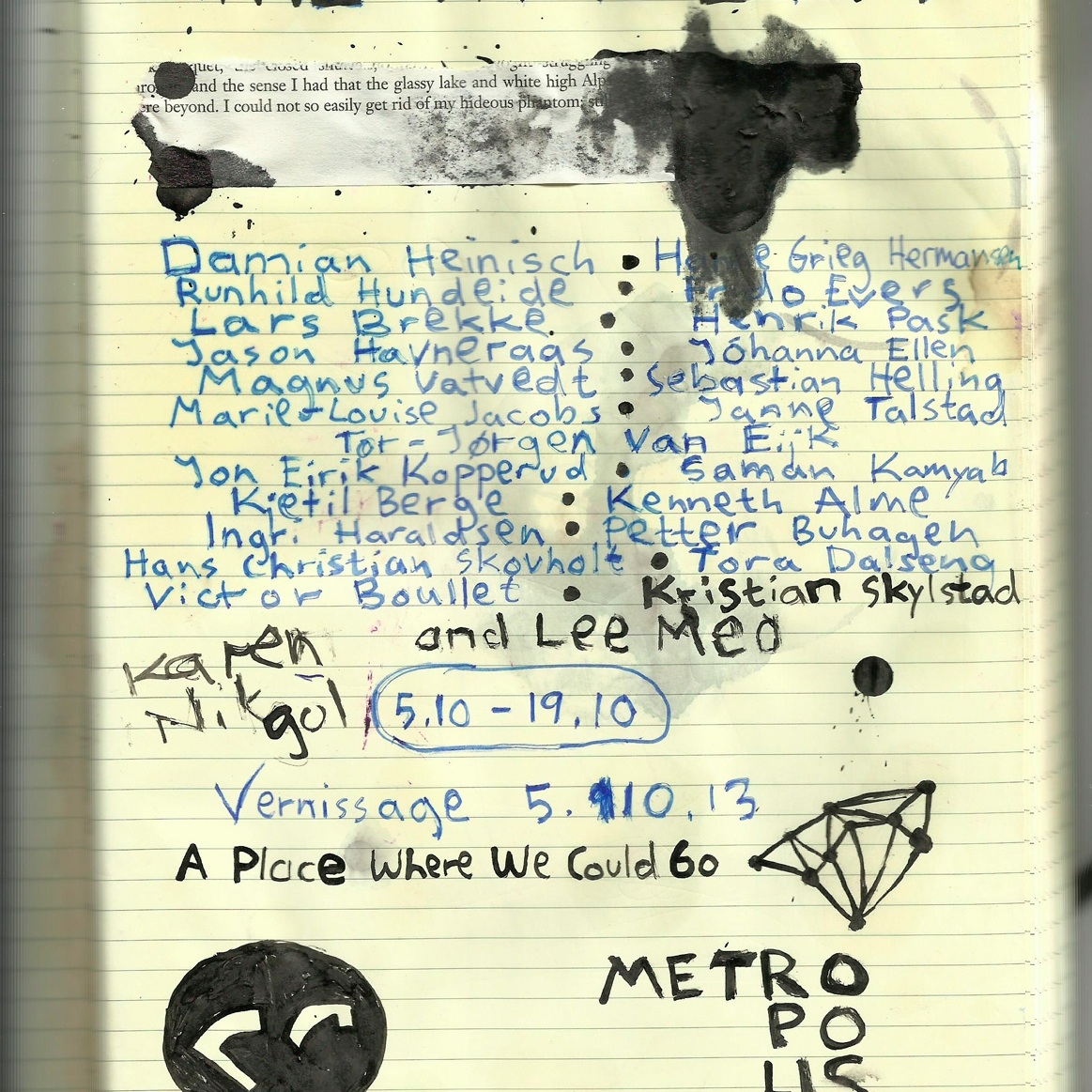artyści / artists: Damian Heinisch, Hanne Grieg Hermansen, Runhild Hundeide, Frido Evers, Lars Brekke & Henrik Pask, Jason Havneraas, Johanna Ellen, Magnus Vatvedt, Sebastian Helling, Marie-Louise Jacobs, Janne Talstad, Tor-J?rgen Van Eijk, Jon Eirik Kopperud & Saman Kamyab, Kjetil Berge, Kenneth Alme, Ingri Haraldsen & Petter Buhagen, Hans Christian Skovholt, Tora Dalseng, Victor Boullet, Kristian Skylstad, Karen Nikgol & Lee Meo
"Porusza się samotnie w swoim domu, a wszystko mówi o nim. Jeżdżą na nartach, ale bardzo daleko. Te obrazki nie są zdjęciami budynków tylko rysunkami. Ten budynek nigdy nie zostanie wybudowany, ponieważ on wybrał bycie artystą, a nie architektem. Wznoszą toast za każdym razem, gdy widzą czarnucha. Niech tusz kapie, niech płynie. Buty, lubię damskie buty i lustra. Pozwól mi śpiewać, śpiewać o nim. Opuszczony krajobraz i ja nagrywający ich inwigilację. Chcę tylko, aby obraz się złaaaamał, złaaamał, rozpłynął się. Dla wszystkiego jest alternatywa, szczególnie dla przecenionego. Myślę liniami, tak myślę, i ważne jest jak oni robią - te linie. Pracujemy razem w miłości. Wpadłem w to przypadkiem, ponieważ się znamy. Jesteś tylko kawałkiem tkaniny zebranym na tanim materiale, który przypadkiem wygląda jak 11 września. Wyślę coś jak będę miał czas. Ktoś jest samotny, w tym mieście wieczorem postaram się zrobić co właściwe, w tym mieście...Ale ja tylko przekształcam cytaty. Jestem fikcją, w którą ty nawet nie wierzysz. DZIAŁAJ."
Kristian Skylstad
"He is moving alone in his house, and everything is about him. They are skiing, but far away. These pictures are not pictures of buildings, but drawings. This building will never be built, because he chose to be an artist instead of an architect. They are cheering every time they see a nigger. Let the ink drop, let it flow. Shoes, I like womens shoes, and mirrors. Let me sing, sing, about him. Desolate landscapes, and here I am, recording their surveillance. I just want the image to brrrreake up, to breeeakkke up, to dissolve. There is an alternative to everything, especially the hype. I think in lines, I do, and I care how they do - the lines. We work together in love. I just stumbbllld into this, by accident, because we know each other. You just piece fabric together on cheap material and accidentially it looks like 911. I'll send something if I have time. Someone is alone, in this city tonight I try to do what's right, in this city... But I only transform quotes. I'm fiction, and you don't even believe it. PERFORM."
Kr?st?an Skylstad
____________________
* Wystawa The City Is Empty ma miejsce w Bytomiu. Jej kurator jest rezydentem w tym mieście. Zaprosił do niej innych, ważnych artystów z Norwegii. Tytuł wystawy odnosi się do norweskiego znaczenie nazwy miasta Bytom - BY (miasto) - TOM (puste).
* The exhibition The City Is Empty takes place in Bytom. Its curator is in the residency programme in this city. He invited other, important artists from Norway to take part. The title of the exhibition directly refers to the Norwegian meaning of the name Bytom - BY (city) - TOM (empty).
O projekcie A Place Where We Could Go:
A Place Where We Could Go (tytuł zapożyczony z piosenki Jeremy Jay´a) stanowi część międzynarodowego programu Projekt Metropolis współorganizowanego przez Fundację Imago Mundi, CSW Kronika w Bytomiu i Muzeum Śląskie. Posługując się różnymi narzędziami sztuki współczesnej, podejmuje on dyskusję wokół naznaczonych stereotypami miejsc o skomplikowanej tożsamości, wydobywa nowe lub zapomniane przestrzenie mentalne regionu Górnego Śląska i Zagłębia Dąbrowskiego, który staje się na czas projektu laboratorium sztuki.
Część prac (sitespecific) eksponowanych będzie w różnych przestrzeniach publicznych miast aglomeracji. Całość projektu podsumują wystawy zbiorowe oraz prezentacje projektu w Polsce, jak i w instytucjach partnerskich. Wystawom towarzyszyć będzie dwujęzyczna publikacja. W projekcie udział biorą: Magda Fabiańczyk, Rafał Jakubowicz, Erla S. Haraldsdottir, Lars Holdus, Paweł Kulczyński, Darri Lorenzen, Krystian Skylstad, Łukasz Surowiec, Fredric Vaerslev.
kurator programu: Stanisław Ruksza
Projekt jest realizowany w partnerstwie z Icelandic Art Center, Reykjavik Art Museum i Kunsthall Grenland.
About the project A Place Where We Could Go:
A Place Where We Could Go, a title borrowed from a song by Jeremy Jay, is part of an international program known as the Metropolis Project, organised jointly by the Imago Mundi Foundation, CCA Kronika of Bytom and the Silesian Museum. Using the various tools of modern art, the project takes up a debate about places of complex identity and stigmatised through stereotypes as well as brings up new or forgotten mental spaces of the region of Upper Silesia and Zagłębie Dąbrowskie which becomes an art lab for the duration of the project.
The site specific part of the work will be exhibited in various public city spaces across the conurbation. The entire project will evaluate exhibitions and presentations of the project in Poland and the partner institutions. The exhibitions will be accompanied by a bilingual publication. The project involves: Magda Fabiańczyk, Rafał Jakubowicz, Erla S. Haraldsdóttir, Lars Holdhus, Paul Kulczyński, Darrie Lorenzen, Krystian Skylstad, Łukasz Surowiec, Fredric Vaerslev.
curator of the programme: Stanisław Ruksza
The project is partnered by the Icelandic Art Centre, Reykjavik Art Museum and the Kunsthalle Grenland.
- Wystawa
- 5‒19 października 2013
- artyści: Damian Heinisch, Hanne Grieg Hermansen, Runhild Hundeide, Frido Evers, Lars Brekke, Henrik Pask, Jason Havneraas, Johanna Ellen, Magnus Vatvedt, Sebastian Helling, Marie-Louise Jacobs, Janne Talstad, Tor Jørgen Van Eijk, Jon Eirik Kopperud, Saman Kamyab, Kjetil Berge, Kenneth Alme, Ingri Haraldsen, Petter Buhagen, Hans Christian Skovholt, Tora Dalseng, Victor Boullet, Kristian Skylstad, Karen Nikgol, Lee Meo
- kurator: Kristian Skylstad
- Projekt zrealizowano w partnerstwie z Icelandic Art Center, Reykjavik Art Museum i Kunsthall Grenland.


















